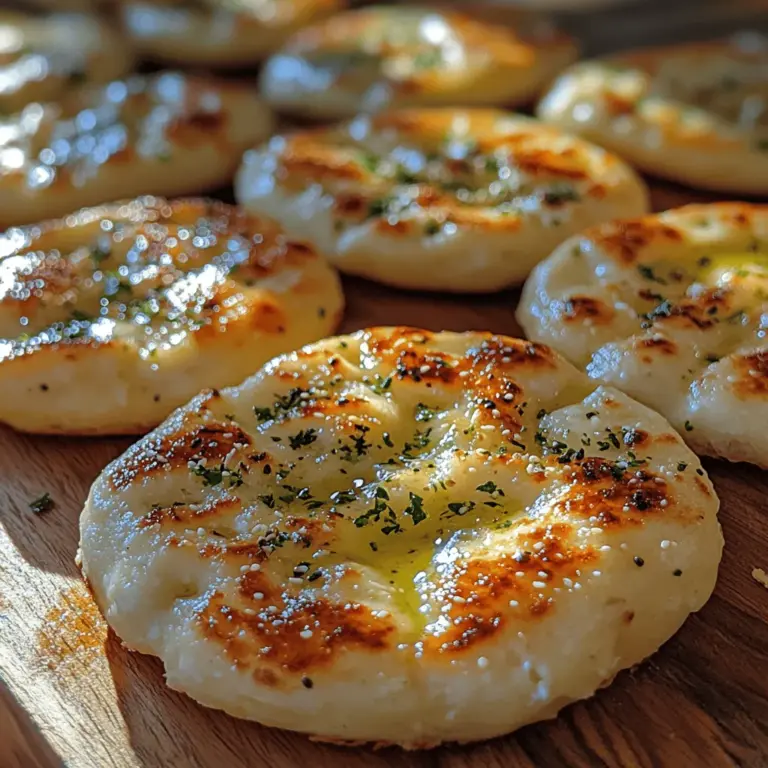Introduction
Cottage cheese, often overlooked in the culinary world, is a powerhouse of nutrition and flavor. Known for its rich protein content and mild taste, it serves as an excellent base for an array of dishes, making it a staple in health-conscious kitchens. In this article, we will explore a delightful recipe for Cottage Cheese Flatbread, a dish that not only showcases the unique qualities of cottage cheese but also provides an easy way to elevate your meals.
Whether you’re hosting a brunch, preparing a quick weeknight dinner, or simply looking for a nutritious snack, this flatbread recipe is versatile enough to suit any occasion. Its light, fluffy texture pairs wonderfully with a variety of toppings, from fresh vegetables to savory spreads, making it a perfect canvas for your culinary creativity. Join us as we dive into the world of cottage cheese and flatbread, and learn how to create this delicious dish from scratch.
Understanding Cottage Cheese
Cottage cheese is a dairy product that has gained popularity for its numerous health benefits. With a high protein content and low fat, it has become a favorite among fitness enthusiasts and those looking to maintain a balanced diet. One cup of low-fat cottage cheese contains approximately 28 grams of protein, making it an excellent choice for muscle repair and growth. Additionally, it’s rich in calcium, phosphorus, and B vitamins, which are essential for bone health, energy production, and overall well-being.
Beyond its nutritional value, cottage cheese adds a creamy texture and subtle flavor to recipes. When used in baked goods or flatbreads, it creates a moist and tender crumb that enhances the overall eating experience. Furthermore, cottage cheese can act as a healthier substitute for heavier ingredients like cream or butter, allowing you to indulge in your favorite recipes with a lighter twist.
Cottage cheese is embraced in various cuisines around the world, often appearing in both sweet and savory dishes. From Eastern European cheese pancakes to Indian paneer, this versatile ingredient adapts well to different flavor profiles and cooking techniques, making it a global favorite. By incorporating cottage cheese into your cooking repertoire, you can explore new culinary horizons while reaping its numerous health benefits.
The Allure of Flatbread
Flatbread has a rich history that spans across cultures and continents. From the ancient Egyptians who made unleavened bread as a staple food to the Indian naan and Middle Eastern pita, flatbreads have been a fundamental part of human sustenance for thousands of years. Their simplicity, made with just a few basic ingredients such as flour, water, and salt, makes them accessible and easy to prepare.
One of the key attractions of flatbread is its adaptability. It can be enjoyed warm or cold, served plain or topped with various ingredients to create a satisfying meal. Flatbreads can be used as wraps, a base for pizzas, or even a side dish accompanying soups and stews. The possibilities are virtually endless, which is why making flatbread at home can be a rewarding experience. Not only do you have control over the ingredients, but you can also experiment with flavors, textures, and toppings to suit your palate.
Homemade flatbread, like our Cottage Cheese Flatbread, offers a freshness and taste that store-bought options often lack. Moreover, making flatbread from scratch allows you to infuse it with your favorite herbs and spices, elevating the dish to new heights. As we embark on this culinary journey, you’ll discover how easy it is to create a delectable flatbread that can be enjoyed in countless ways.
Ingredients Breakdown
To make Cottage Cheese Flatbread, you will need a few essential ingredients that come together to create a delicious and versatile dough. Here’s a breakdown of what you’ll need:
1. Cottage Cheese: The star ingredient, cottage cheese adds moisture and a unique flavor to the flatbread. Opt for low-fat or full-fat versions depending on your dietary preferences. The creaminess of cottage cheese not only benefits the texture but also enhances the nutritional profile of the flatbread.
2. All-Purpose Flour: This is the primary component of the flatbread dough. All-purpose flour provides structure and helps bind the ingredients together. For a whole grain option, consider using whole wheat flour, which will add additional fiber and nutrients.
3. Egg: The egg acts as a binding agent, helping to hold the dough together. It also contributes to the flatbread’s richness and provides a slight lift during cooking, resulting in a light and airy texture.
4. Oil: A small amount of oil (such as olive oil or vegetable oil) is added to the dough to enhance flavor and improve the texture. It helps to keep the flatbread moist and tender while also adding a subtle richness.
5. Salt: A pinch of salt is essential for flavor enhancement. It balances the natural sweetness of the cottage cheese and brings the other flavors together.
6. Fresh Herbs (Optional): Adding fresh herbs such as chives, parsley, or dill can infuse the flatbread with vibrant flavors. Experimenting with different herbs allows you to customize the flatbread to complement your meal.
7. Optional Toppings: The beauty of flatbread lies in its versatility. Consider toppings such as cheese, vegetables, or spreads (like hummus or tzatziki) to create a satisfying dish that suits your taste.
Understanding the role of each ingredient is crucial for achieving the perfect Cottage Cheese Flatbread. The combination of cottage cheese, flour, and binding agents creates a dough that is both pliable and flavorful. With this foundation, you can elevate your flatbread experience by incorporating fresh herbs and other toppings that reflect your culinary preferences.
Step-by-Step Instructions
Preparing the Dough
Now that we have a clear understanding of our ingredients, it’s time to dive into the preparation of the Cottage Cheese Flatbread dough. The process is straightforward, ensuring that even beginner cooks can successfully create this delightful dish.
1. Mixing the Ingredients: Begin by placing your cottage cheese in a mixing bowl. If you prefer a smoother texture, you can blend the cottage cheese using a food processor or a hand blender. This step is optional but can help create a more uniform dough.
2. Incorporating the Flour: Gradually add the all-purpose flour to the cottage cheese. Use a spatula or wooden spoon to gently fold the flour into the cottage cheese until it begins to come together. Be careful not to overmix; you want the ingredients to combine without developing too much gluten, which could lead to a tough flatbread.
3. Adding the Egg and Oil: Once the flour is incorporated, add the egg and oil to the mixture. The egg serves as a crucial binding agent, ensuring that the flatbread holds together during cooking. The oil adds moisture and richness to the dough. Gently mix until the egg and oil are fully incorporated, and the dough starts to take shape.
4. Kneading the Dough: Transfer the dough onto a lightly floured surface and begin to knead. Kneading helps develop the gluten structure, giving the flatbread its desirable chewy texture. Knead the dough for about 2-3 minutes until it becomes smooth and elastic. If the dough is too sticky, sprinkle a little extra flour as needed.
5. Resting the Dough: Once kneaded, shape the dough into a ball and place it back in the mixing bowl. Cover it with a clean kitchen towel or plastic wrap and let it rest for about 15-30 minutes. This resting period allows the gluten to relax, making it easier to roll out the flatbreads later on.
By following these initial steps, you will have a dough that is ready to be transformed into delicious Cottage Cheese Flatbreads. The combination of cottage cheese, flour, egg, and oil creates a unique texture and flavor profile that elevates this simple dish into something truly delightful. As we continue with the recipe, you’ll discover the next steps to bring your flatbread to life.
Incorporating Herbs: How Fresh Herbs Enhance the Flavor Profile
Incorporating fresh herbs into your Cottage Cheese Flatbread Delight can elevate the flavor profile significantly. Herbs like basil, dill, parsley, and chives not only add freshness but also impart a fragrant aroma that can make your flatbreads irresistible. For a Mediterranean twist, consider using oregano and thyme, which pair beautifully with the creamy texture of cottage cheese.
To incorporate herbs, simply chop a handful of your chosen fresh herbs finely and mix them into the dough during the initial stages of preparation. This allows the flavors to meld and infuse throughout the flatbread, ensuring that every bite is packed with herbaceous goodness. Additionally, you can sprinkle some herbs on top of the flatbreads just before cooking for an extra burst of flavor.
Kneading the Dough: Tips for Achieving the Perfect Texture
Kneading is a crucial step in making your flatbread, as it helps develop gluten and creates a smooth, elastic texture. When kneading your dough, it’s essential to strike the right balance; you want the dough to be soft yet not overly sticky. Here are some tips to achieve the perfect dough texture:
1. Flour Gradually: Add flour gradually while kneading. This prevents the dough from becoming too dry. If the dough feels tacky, sprinkle small amounts of flour until you achieve a smooth consistency.
2. Knead Properly: Use the palm of your hand to push the dough away from you, then fold it back towards you. Rotate the dough and repeat this process for about 5-7 minutes. You’ll know it’s ready when it springs back lightly when pressed.
3. Resting Time: After kneading, let the dough rest for about 15-30 minutes. This resting period allows the gluten to relax, making it easier to shape the flatbreads.
Dividing and Shaping: Best Practices for Portioning and Flattening the Dough
Once your dough has rested, it’s time to divide and shape it into flatbreads. Here’s how to do it effectively:
1. Portioning: Use a knife or bench scraper to divide the dough into equal pieces, about the size of a golf ball. This will ensure that your flatbreads cook evenly.
2. Shape into Balls: Roll each portion into a ball by cupping your hand over the dough and moving it in a circular motion. This helps create a smooth surface.
3. Flattening: On a lightly floured surface, use a rolling pin to flatten each ball into a round disc, approximately 1/4 inch thick. For a rustic look, you can also use your hands to gently press and stretch the dough.
4. Uniform Size: Aim for uniform thickness for even cooking. If you want to get creative, you can shape your flatbreads into different forms, like triangles or rectangles.
Cooking the Flatbreads: Ideal Cooking Temperatures and Techniques for Perfect Results
Cooking your flatbreads correctly is essential to achieving that crispy exterior while keeping the inside soft and fluffy. Here’s a step-by-step guide on how to cook your Cottage Cheese Flatbreads:
1. Preheat the Cooking Surface: Whether you’re using a skillet, griddle, or oven, preheat it to medium-high heat. If using a skillet, allow it to heat for about 5 minutes. A well-heated surface ensures that the flatbreads cook quickly and evenly.
2. Cooking Method: Place the flattened flatbread onto the hot surface. Cook for about 2-3 minutes on one side until you see bubbles forming on the surface and the edges start to lift.
3. Flip and Cook: Flip the flatbread using a spatula and cook for another 1-2 minutes on the other side. The flatbread should develop golden-brown spots.
4. Keep Warm: To keep your flatbreads warm while you cook the remaining pieces, stack them on a plate and cover them with a clean kitchen towel. This helps maintain their soft texture.
Optional Toppings: Creative Ways to Enhance Flavors Before Serving
Before serving your Cottage Cheese Flatbreads, consider adding toppings to enhance their flavors. Here are some creative ideas:
– Herbed Oil Drizzle: Mix olive oil with minced garlic and your choice of herbs, then drizzle over the warm flatbreads.
– Cheese: Sprinkle some grated cheese, such as feta or mozzarella, on top of the flatbreads while they are still hot, allowing it to melt slightly.
– Veggies: Top with thinly sliced tomatoes, cucumbers, or bell peppers for a refreshing crunch.
– Spices: Add a sprinkle of za’atar or sumac for a Middle Eastern flair.
Serving Suggestions
Cottage Cheese Flatbreads are incredibly versatile and can be served in various ways:
1. As a Side Dish: Serve warm flatbreads alongside grilled meats or roasted vegetables for a wholesome meal. They can also replace traditional bread in any meal, offering a healthy alternative.
2. Dips and Spreads: Pair your flatbreads with dips like hummus, tzatziki, or a creamy avocado spread. These accompaniments not only taste great but also add nutritional value.
3. Wraps for Fillings: Use the flatbreads as a wrap for fillings such as grilled chicken, falafel, or a medley of roasted vegetables. Add fresh greens like spinach or arugula for added nutrition and crunch.
Culinary Variations
To customize your Cottage Cheese Flatbreads, consider these variations:
1. Herbs and Spices: Experiment with different herbs and spices to create unique flavor profiles. Try adding cumin, coriander, or red pepper flakes to the dough for a more robust flavor.
2. Alternative Flours: For those with dietary preferences, consider using whole wheat, spelt, or gluten-free flours like almond or coconut flour. Each flour will impart a different texture and flavor to your flatbreads.
3. Sweet Versions: For a delightful twist, create a sweet version of the flatbreads. Replace some of the flour with additional cottage cheese, add a touch of cinnamon, and serve with honey or fruit preserves for a delicious breakfast option.
Nutritional Information
Understanding the nutritional value of your Cottage Cheese Flatbreads can help you appreciate their health benefits:
– Calories: A serving (one flatbread) contains approximately 90-100 calories.
– Nutritional Breakdown: Each flatbread provides about 6 grams of protein, 1-2 grams of fat, and 15 grams of carbohydrates. It’s also a good source of calcium and offers beneficial probiotics from the cottage cheese.
Compared to store-bought flatbreads, homemade versions are often free from preservatives and additives, making them a healthier choice for you and your family.
Conclusion
In summary, Cottage Cheese Flatbread Delight is a simple yet versatile recipe that can be tailored to suit any flavor preference. With its delightful combination of health benefits and culinary creativity, it encourages you to explore the world of cooking with cottage cheese.
Try making this flatbread at home for a wholesome meal that is sure to impress. By incorporating more cottage cheese into your cooking, not only will you enjoy its rich flavor and texture, but you will also benefit from its nutritional advantages, making every meal a little healthier. Enjoy the process of making these flatbreads and the satisfaction that comes from creating something delicious from scratch.


